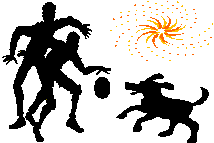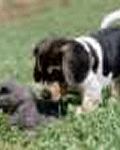The Memory Process
Memory is the ability to relate to new situations from a past experience.
|
Now that we have our dogs learning during our sessions, the next step would be to understand memory theory. Memory deals with how the information is stored in the brain. Memory is the ability to relate to new situations from a past experience. The process in memory consists of first encoding the information from an experience, which consists of analyzing, processing, then digesting the new information. Then the student stores the information in the brain and, depending on the level of importance, will be placed in an area of the brain ready for recall. Recall is the third phase in the memory process. The ability to retrieve the information will be primarily based on how the information was learned. The reaction of the student will be based on past experience, whatever information is found and compared to the present situation, then the decision of how to respond is influenced by the past. |
After analyzing and processing the information, depending on the level of impression of the last experience, the information will be stored in different levels of memory. Science has termed the levels of memory in the following ways. First is the very short-term memory or VSTM. The VSTM acts like a receptionist for the brain; it takes all the information from the outside world and decides on its level of importance. This is why it is important to reduce the level of distractions during training, because the outside distractions all effect what is learned. The second level is the short-term memory or STM. This is the level where it takes information from the receptionist and decides where and how the experience will be stored for later retrieval. The knowledge learned is processed, then put in proper perspective. The third level is the intermediate-term memory or ITM. This is the location in the brain where, in the opinion of the student, there's a moderate amount of importance. This memory is usually stored for about a week or so. This area in the brain is similar to a shelf we use to place our bills; once we deal with them, others are sent to replace the old ones.
|
|
The last level is long-term memory or LTM. After an intensive learning process at the lower levels of memory, finally it is placed in the long-term memory. This is the area in the brain that also shapes the personality of the dog. The dog's behaviors are shaped by the attitudes from past-learned experiences. When we deal with behavior modification we work with the LTM: how the dog has stored information and how we change the way the information is processed depends on the dog's reactions to new information. The process of storing learned material from the lower levels to the long-term memory is called consolidation or learning. |
Scientists, through the use of laboratory animals, have found that when a pleasant experience follows a learning session, that lesson is easily recalled at a later time. On the other hand, when a session was followed by a shocking experience, that information was not available for retrieval. This is why we suggest that after a session, we play with our dogs to allow the experience to end in pleasure. Also, we never end work through a session when we are angry or frustrated because the dog will sense the unpleasant experience and wish to avoid it and everything associated with it in the future. Always end a session with reward and play for the best-learned experience for the student. |
. |
Continue to Practice Makes Perfect








